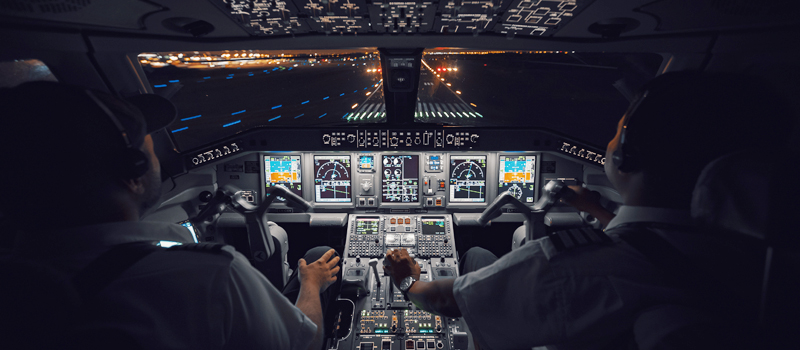-
Introduction
-
Key Takeaways
-
What Is Air Density?
- Why Air Density Matters in Aviation
-
Factors Affecting Air Density
- Pressure
- Temperature
- Humidity
- Altitude
-
Impact of Air Density on Aircraft Performance
- Effects on Lift
- Effects on Engine Power
- Effects on Propeller Efficiency
- Overall Aircraft Performance
-
What Is Density Altitude?
- How to Calculate Density Altitude
- Tools to Calculate Density Altitude
- Importance of Density Altitude for Pilots
-
Practical Applications for Pilots
- Pre-Flight Considerations
- Adjusting Flight Operations Based on Air Density
-
Frequently Asked Questions About Air Density in Aviation
- Is Denser Air Better for Flying?
- Does Flying in Greater Air Density Increase Lift?
- Is High Air Density Good for Flying?
- How Does Humidity Affect Air Density?
-
Conclusion
Introduction
You’re ready for takeoff on a hot, humid day at a high-altitude airport – is your aircraft prepared for the challenge?
For pilots, understanding air density isn’t just about physics; it’s about safety and efficiency in every flight.
Knowing how to calculate and adjust for air density can make a difference.
In this article, we will cover everything you need to know about air density and how it can affect your performance.
Key Takeaways
- Air density affects aircraft performance, including lift, engine power, and propeller effectiveness.
- Factors influencing air density include altitude, temperature, pressure, and humidity.
- High-density altitude reduces aircraft performance, requiring flight adjustments.
- Pilots calculate density altitude to assess and compensate for changes in air density.
- Realizing air density is invaluable for flight operations.
What Is Air Density?
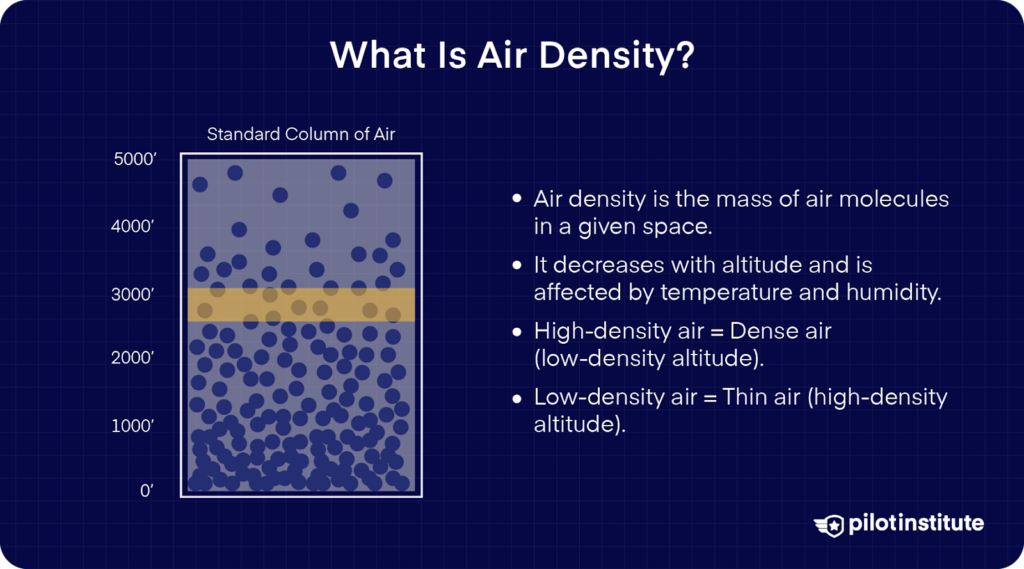
Air density is the mass of air molecules within a given volume, measured in kilograms per cubic meter.
Like pressure, air density decreases with altitude. It can also be affected by changes in temperature and humidity.
When we talk about high-density air, we refer to dense air, whereas with low-density air, we refer to thin air. A high-density altitude means the air is thin, while a low-density altitude means the air is dense.
Why Air Density Matters in Aviation
So why do we have to know about it?
Air density is fundamental in aviation.
It affects several factors that are important to us when flying. These include lift, propeller thrust, and engine combustion. All of these contribute to aircraft performance.
We will review these factors in detail shortly.
Factors Affecting Air Density
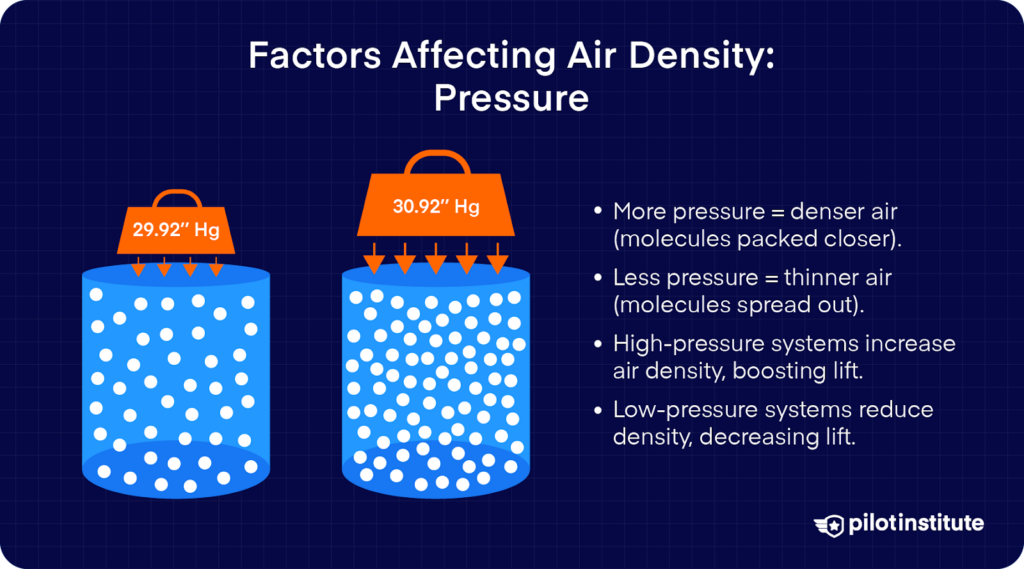
So, we know what air density is and why we need to know about it. But what factors can cause it to change?
The density of the air depends on a few factors. These include its pressure, temperature, and water vapor content. Let’s take a closer look at each of these factors in more detail.
Pressure
You can think of pressure as a force exerted onto a parcel of air. As you apply more force, more air molecules are crowded into a given volume.
When more pressure is applied to a parcel of air, it becomes denser. Meanwhile, lower pressure results in less dense air, as the particles are more spread out.
As the atmospheric pressure changes, so does air density.
When flying through a high-pressure weather system, the same volume of air contains more molecules. This increased density increases airflow over the wings, generating more lift.
The opposite is true for low-pressure weather systems. Fewer air molecules result in less dense air, which means less lift.
Temperature
When air is heated, the molecules vibrate and move from the extra energy. This extra energy causes the molecules to spread further apart, reducing air density.
Temperature and air density have an inverse relationship. This means that air density decreases as temperature increases, and vice versa.
The difference between hot and cold days at airports can drastically impact your aircraft’s performance.
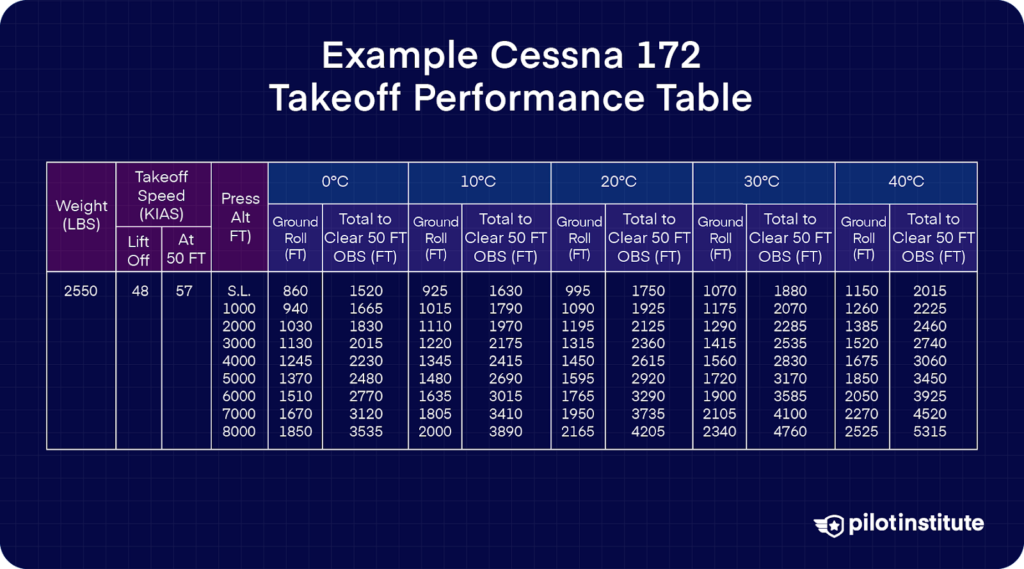
The table above shows the short-field takeoff performance of a Cessna 172.
For example, if we were to takeoff on an airfield at sea level at 0°C (32°F), it would take 1520ft to reach our obstacle clearance height of 50ft.
Whereas for the same airfield on a different day, if it were 30°C (86°F), that same obstacle clearance height would take 1880ft.
That’s an extra 360ft!
As you can see, temperature really does significantly impact our performance.
Humidity
Humidity is the concentration of water vapor that is present in the air. Like pressure and temperature, humidity also affects air density.
The amount of water vapor in the atmosphere directly impacts air density. Since water vapor is lighter than air, if there is high humidity, then the air will be less dense.
Although humidity doesn’t have as great an effect on air density as temperature and pressure, it can still impact performance.
Altitude
As altitude increases, pressure and temperature decrease, which has a conflicting effect on air density.
However, the decrease in pressure with altitude occurs reasonably quickly. This tends to have a more significant impact on air density compared to temperature.
International Standard Atmosphere (ISA)
ISA is a model that describes the average conditions of the Earth’s atmosphere.
As pilots, we can use ISA as a reference for performance calculations.
ISA is based on specific pressure, temperature, and air density values at mean sea level, all of which decrease with altitude.
The standard values are as follows:
- Pressure 1013.2 millibar – With pressure decreasing at approximately one hectopascal (hPa) per 27 ft.
- Temperature 15°C (59°F) – With the temperature decreasing at 1.98°C/1000ft until 36,090ft where it remains constant at -56.5°C (-69.7°F).
- Air Density – 1.225m³.
Airfields situated at higher altitudes present more challenges for pilots. The reduced pressure, and therefore air density, impacts our aircraft performance.
Below is an illustration that shows the effect of altitude on takeoff run and rate of climb.
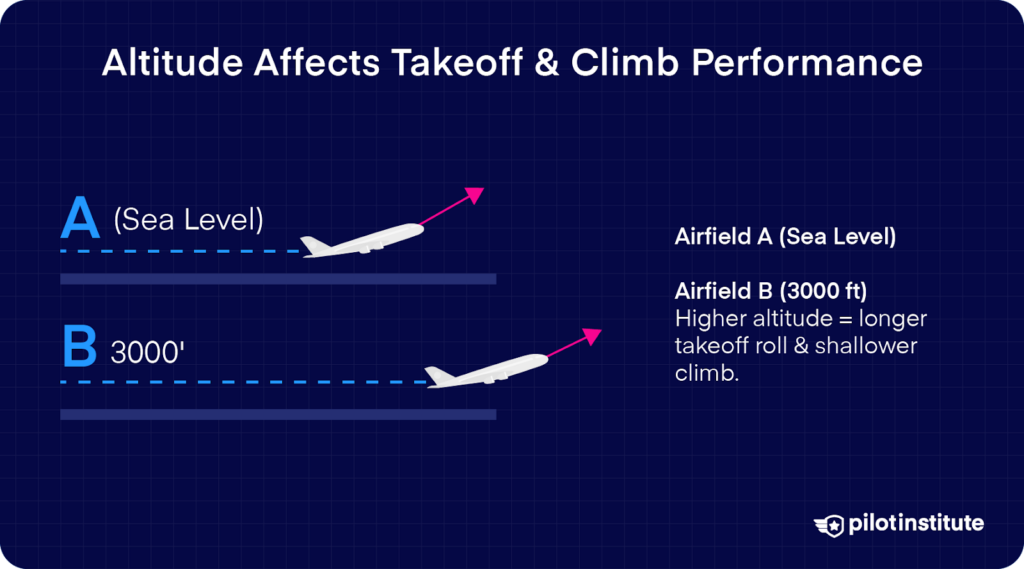
Airfield A is at sea level, whereas Airfield B is situated at 3000ft.
Due to the reduced pressure and air density at Airfield B, the takeoff run will be longer, and once airborne, the rate of climb will be shallower.
This can become a real danger when paired with hot temperatures, further reducing air density.
Pilots must be sure that their aircraft has the performance required to get airborne in such conditions.
Impact of Air Density on Aircraft Performance
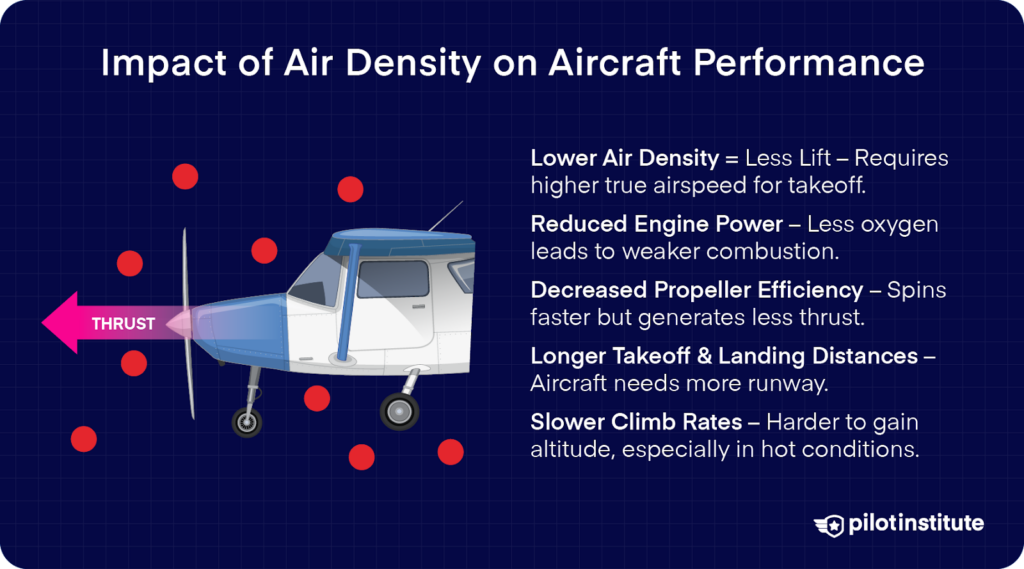
Now, to the important part. It is crucial to have confidence in our aircraft’s performance. Especially when operating out of performance-limited airfields.
Knowing how air density affects our performance allows us to gauge whether we can get airborne off an airfield on a particular day.
Let’s look at what exactly air density can impact when it comes to performance.
Effects on Lift
For an aircraft to fly, we need sufficient airflow over the wing. Air density plays a part in this when it comes to lift generation.
As the air becomes less dense, lift reduces. This is due to the thinner, less dense air exerting less force on the wings.
This means that if you encounter these conditions on a particular day, you would need to achieve a higher true airspeed to produce the same lift that would be generated at lower airspeeds in denser air.
Effects on Engine Power
Engines require three things to produce power—oxygen, fuel, and ignition.
Air is often taken for granted when it comes to engine power, as we tend to overlook its importance. However, the amount of air that flows into an engine is critical for its performance.
When it comes to air, for the best performance, we want it to be dense and cool.
Having a high air density means more oxygen is available, increasing combustion and power.
This is why we get better performance at lower altitudes, as there is more air to support combustion.
Effects on Propeller Efficiency
The concept above applies to propeller efficiency. Reduced air density means the propellers generate less lift as they rotate.
With less dense air, propellers also have less air resistance to oppose.
While it might initially sound like a good thing, it actually isn’t. This is because it will spin faster. This actually decreases the engine’s efficiency in converting engine power into thrust.
Reduced thrust means decreased aircraft performance and fuel efficiency.
Jet engines also experience reduced thrust in less dense air. Jet engines use air for combustion and propulsion, so with less dense air, less gas is forced out of the exhaust, which leads to reduced thrust.
Overall Aircraft Performance
To summarize, the greater the air density, the better the aircraft performance.
Decreased air density leads to longer takeoff runs, reduced climb rates, and increased landing distances.
Knowing how air density affects aircraft performance calculations is extremely important. If not fully understood, it can cause you to get into trouble if not accounted for.
What Is Density Altitude?
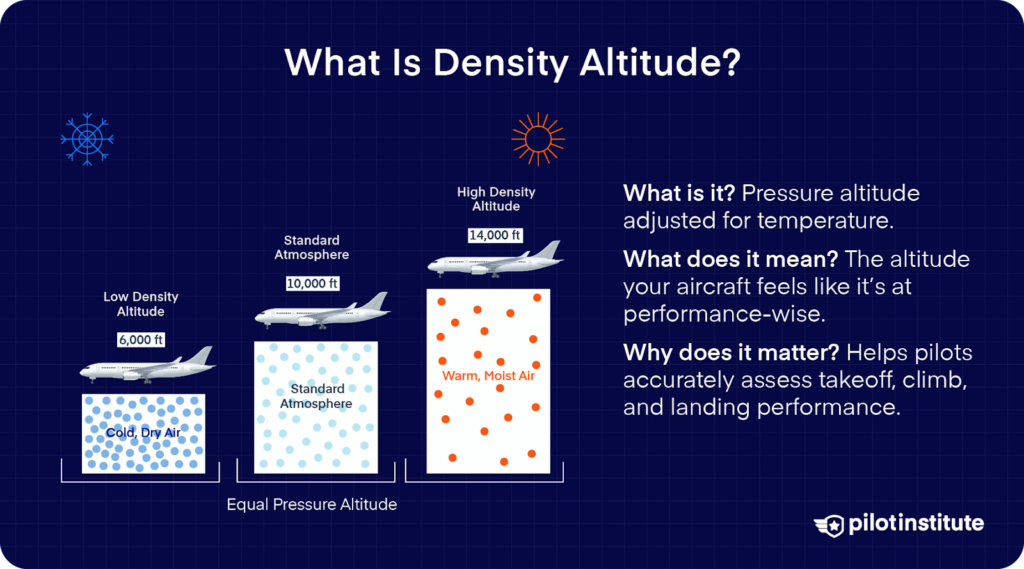
We’ve been talking a lot about air density, but what is density altitude? Density altitude is the pressure altitude corrected for the non-standard temperature.
So, what does that mean in simple terms?
It’s the altitude at which the aircraft “feels” it’s operating at in terms of its performance. Keep in mind that it isn’t a physical altitude.
Density altitude is a vital concept for pilots to understand when evaluating aircraft performance. Knowing how to calculate it ensures you are being as accurate as you can when assessing performance.
How to Calculate Density Altitude
If math isn’t your strong point, don’t worry. Calculating density altitude is relatively straightforward.
To calculate the density altitude, we need two things: the pressure altitude and the outside air temperature.
Pressure altitude and standard temperature can be calculated using the ISA values.
Density Altitude = Pressure Altitude + [120 x (OAT – Standard Temperature)]
For example, the temperature at a pressure altitude of 5,000ft is 7°C.
Density Altitude = 5000 + [120 x (7 – 5)] Note: 5°C is the ISA Temp at 5000ft.
= 5240ft
This means the aircraft will “feel” like it’s flying at 5240ft because the warmer temperature (ISA+2°C) means the air is less dense.
Note: OAT and ISA Standard Temperature should be in degrees Celsius. This formula is an approximation and does not factor in humidity.
Tools to Calculate Density Altitude
Using the formula above is one way to calculate the density altitude. We also have multiple tools to help simplify the process, so we don’t have to write out formulas constantly.
Flight Computers
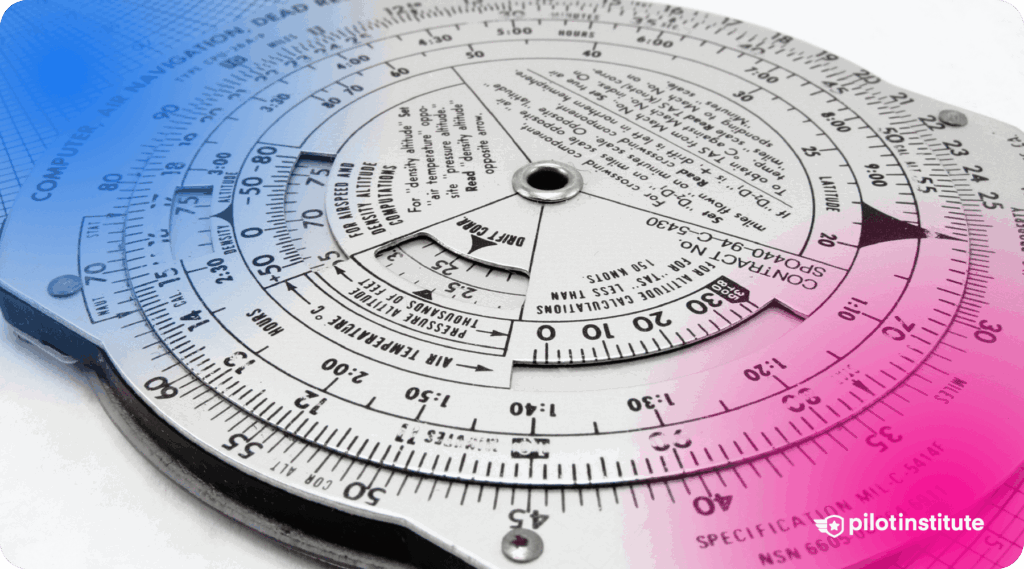
Flight computers such as the E6B have the functionality to calculate density altitude.
It consists of an outer rotatable metal disc that allows you to change pressure altitude, as well as temperature values.
Consult sources on the specific use of a flight computer, like an E6B, for determining density altitude.
For example, to calculate density altitude using an E6B, align the pressure altitude with the outside air temperature. The density altitude can then be read from the appropriate window.
Phone Apps
There are specialized apps you can download onto your mobile device that are made to calculate density altitude.
This is a great way to find an instant answer when you are out flying
Aircraft Manuals
If all else fails and you don’t have your phone or flight computer, you can dive into the aircraft manuals.
Under the performance section there are graphs for calculating take-off and landing distances. These graphs are adjusted for the atmospheric conditions.
Importance of Density Altitude for Pilots
So why do we have to know so much about density altitude?
High-density altitudes can pose risks to pilots. Even more so when taking off from a hot, high-elevation location with high humidity.
We know that a high-density altitude reduces aircraft performance. The air is far less dense, which means that takeoff and landing distances will be increased. Resulting in a decreased rate of climb.
Pilots must calculate the anticipated density altitude for the airfields they will be operating into.
Miscalculating density altitude can lead to runway excursions and fatalities.
Practical Applications for Pilots
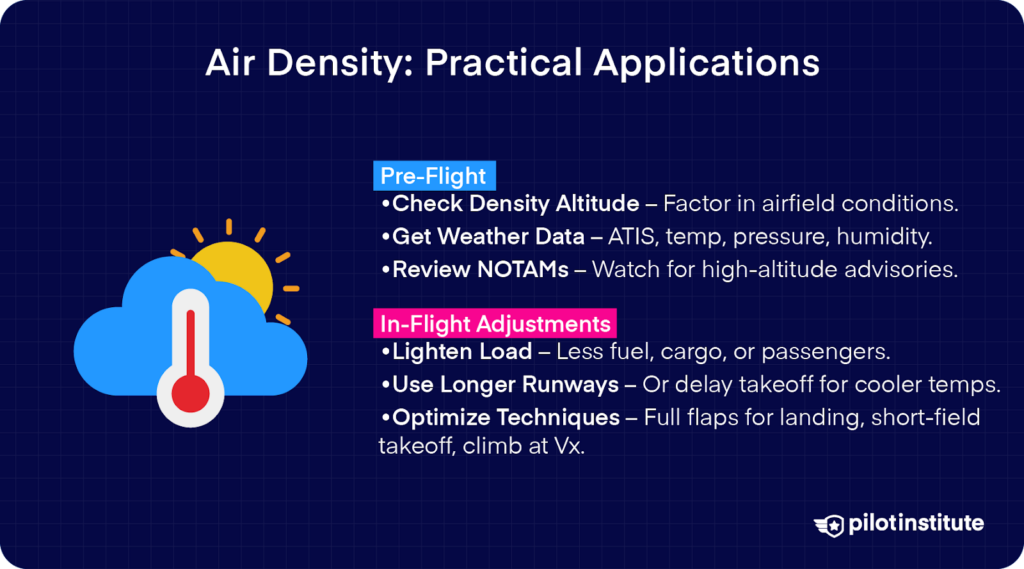
Enough theory. Let’s get into some practical applications around air density.
Pre-Flight Considerations
When planning a flight, include air density calculations for all of the airfields you plan to take off and land on.
Obtain current weather data from an ATIS or local weather station for accurate calculations. You want to obtain the airfield’s temperature, pressure, and humidity.
Check NOTAMs and weather briefings for any density altitude advisories. Airports with elevations of 2,000ft and higher will broadcast an advisory when the high-density altitude may be an issue.
Adjusting Flight Operations Based on Air Density
You can do a few things to your operation that will help reduce the effect of high-density altitudes.
Reduce Aircraft Weight
Reducing aircraft weight will improve your performance and help you get airborne faster.
Consider taking less fuel, cargo, or passengers when operating into high-density airfields. This will give you the best chance of taking off safely again.
Longer Runways
If you are planning a cross-country flight, consider landing at longer runways. This will give you a performance buffer when density is high.
If no longer runways exist, consider delaying your takeoff until the temperature decreases.
This tends to occur late afternoon/evening, so you could plan for an afternoon flight to avoid the hot temperatures.
Adjust Flight Techniques
Simple adjustments to how you fly the aircraft can also help you improve its performance. Consider using full flap when landing to ensure slower airspeeds and reduced ground roll.
When taking off, doing a short-field takeoff and climbing out at the best angle of climb speed (Vx) will maximize performance.
Frequently Asked Questions About Air Density in Aviation
Is Denser Air Better for Flying?
Yes, denser air improves aircraft performance. This is because denser air provides more molecules for lift generation, engine combustion, and propeller thrust.
The best performance will occur on cold, dense air days, compared to warm, less dense air days.
Does Flying in Greater Air Density Increase Lift?
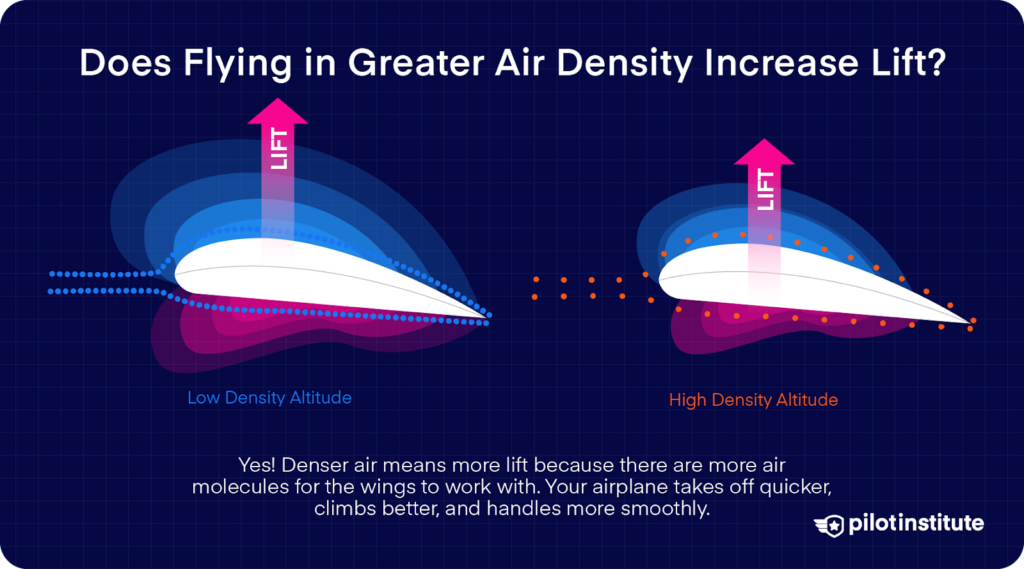
Yes, increased air density leads to increased lift.
Through the lift equation, we can see that lift is proportional to air density. Assuming all other factors are constant, if we increase air density, we increase lift.
So, on days when we are taking off or landing at an airfield with low air density, we require faster true airspeeds to generate the required lift.
This increased true airspeed, along with other factors increases takeoff and landing distances. It may also affect true airspeed at various indicated airspeeds, and that should also be taken into consideration.
Is High Air Density Good for Flying?
Yes. High air density is better for aircraft performance.
High-density altitude, on the other hand, indicates thin air. Low-density altitude indicates air is dense.
So, for the best performance, we want high-density air, which corresponds to a low-density altitude.
How Does Humidity Affect Air Density?
Humidity does decrease air density, and this effect should be considered, especially in warm, humid conditions.
It’s a smaller factor than temperature and pressure, but it still has a measurable effect on aircraft performance.
Consider the humidity when operating into airfields at high elevations, on hot days, or when humidity is particularly high, as it will reduce aircraft performance.
Conclusion
Understanding the basics of air density is fundamental in aviation.
Knowing how it changes and impacts your aircraft’s performance will allow you to take extra precautions when faced with challenging climates.
Thorough pre-flight planning and performance calculations will ensure your aircraft can perform on a particular day. Keeping you and your passengers safe.

